SQL Maestro for MySQL 14.2 released
Feb 3, 2014
| Prev | Next |
|
SQL Maestro Group is happy to announce the release of SQL Maestro for MySQL 14.2, a powerful Windows GUI solution for MySQL administration and database development. Please consider the list of new features implemented in this version since the last official release: |
Server management extensions:
-
This version of the software has been successfully tested with all the modern MySQL versions up to MySQL 5.7.3 (the latest version available at the moment). We have also implemented support for some MySQL 5.7 new features:
- Now it is possible to define multiple triggers for a given table that have the same trigger event and action time to fire in a specified order. By default, the triggers activate in the order they were created.
 Picture 1. Multiple trigger creation: setting the trigger order.
Picture 1. Multiple trigger creation: setting the trigger order.
- Starting from this version SQL Maestro for MySQL generates the ALTER TABLE ... RENAME INDEX statement to rename an index (instead of DROP/CREATE).
- Support for the password-expiration capability has been implemented (MySQL 5.6+). This feature allows you to expire a password for any account in a single click.
 Picture 2. User Editor: setting a password as expired.
Picture 2. User Editor: setting a password as expired.
- Now it is possible to define multiple triggers for a given table that have the same trigger event and action time to fire in a specified order. By default, the triggers activate in the order they were created.
- A new implementation of HTTP tunneling based on MySQLi PHP extension has been added. The installation folder now contains two connection scripts: mysqli_tunnel.php and mysql_tunnel.php. We would recommend you to use the mysqli_tunnel.php script always if possible as it operates through the modern MySQLi PHP extension (available since PHP 5) while mysql_tunnel.php uses the original MySQL PHP API that is deprecated as of PHP 5.5.
 Picture 3. Connecting via MySQLi based HTTP tunnel
Picture 3. Connecting via MySQLi based HTTP tunnel
-
Support for keyboard interactive SSH authentication has been implemented. This method provides for a multiple challenge-response dialog with the user in which the server sends a text query to the user, the user types in a response, and this process can repeat any number of times to ensure that the client is a human.
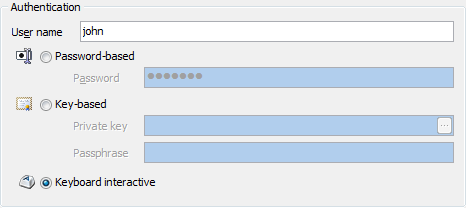 Picture 4. SSH Options: keyboard interactive authentication
Picture 4. SSH Options: keyboard interactive authentication
- Starting from this version it is possible to change the default database character set and collation (these settings are used as default values for newly created tables if the table character set and collation are not specified explicitly). To modify the default character set and/or collation for a database, you must have the ALTER privilege on this database.
 Picture 5. Database Editor: changing the default collation.
Picture 5. Database Editor: changing the default collation.
- Support for the bit data type has been significantly improved:
- Starting from this version the columns of bit(1) data type are represented in the data grids as checkboxes (the checked state corresponds to the value '1', and the unchecked one to the value '0').
- The values of the bit(m), m > 1 data types are now displayed and edited as the corresponding integers from 0 to 2m - 1. For example, binary literals b'0111' and b'1010' are represented in the data grid as 7 and 10, respectively.
 Picture 6. Data Grid: bit values.
Picture 6. Data Grid: bit values.
- Binary literals used as default values for columns of bit data type are now displayed correctly in the table's SQL definition.
-
The time of the table creation is now displayed in the Table Editor, Database Editor, and Object Browser.
 Picture 7. Table Editor: time of the table creation
Picture 7. Table Editor: time of the table creation
Interface improvements:
-
Nullable Column Checker has been implemented. This feature allows you to refactor your database schema by enforcing omitted NOT NULL constraints. It is useful, for example, if you have got a legacy schema with a lot of columns allowing NULL values and plenty of data. To invoke the wizard, use the appropriate link in the Generate SQL section of the table popup menu at the Explorer tree.
 Picture 8. Nullable Column Checker
Picture 8. Nullable Column Checker -
Advanced data grid features such as lookup editors and column header images become available on working via an HTTP tunnel.
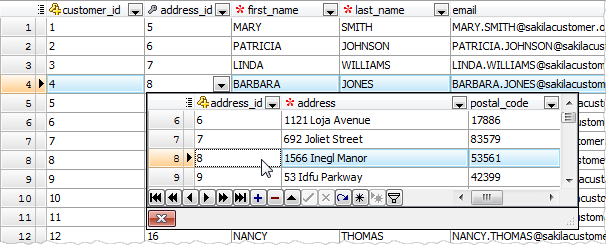 Picture 9. Advanced data grid features
Picture 9. Advanced data grid features -
Data Import features:
-
Starting with this version it's possible to import data from several files at a time. To import data from multiple files with the same structure, set the mask of the file names to the corresponding field. To see the list of matching files, use with the button on the right.
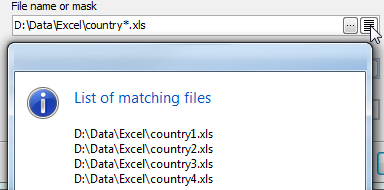 Picture 10. Import data from multiple files
Picture 10. Import data from multiple files -
The Column Builder for text files with fixed column width has been redesigned. Now to set the correspondence between table columns and areas of a text file, you can either input offset and width for each column directly into the controls, or define these values by clicking the left mouse button in the right area of the tool.
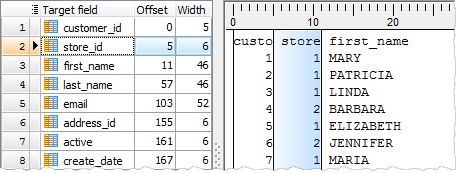 Picture 11. Column Builder for text files with fixed column width
Picture 11. Column Builder for text files with fixed column width - Now it's possible to add current timestamp to the log file name using the %ts:TIMESTAMP_FORMAT% string template. Examples of valid datetime formats are: 'YYYY-MM-DD', 'YYYY-MM-DD-HH24-MI', 'YYYY-MM-DD-HH24-MI-SS', and so on.
- Now each time you start the wizard to import data to a table it stores all the options as them were set on the previous session of working with this table.
-
Starting with this version it's possible to import data from several files at a time. To import data from multiple files with the same structure, set the mask of the file names to the corresponding field. To see the list of matching files, use with the button on the right.
- Data Export: Support for Json file format has been implemented.
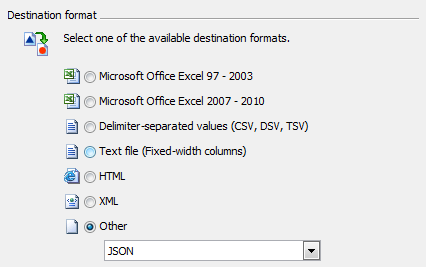 Picture 12. Data Export to JSON
Picture 12. Data Export to JSON
In addition to this, several bugs have been fixed and some other minor improvements and corrections have been made.
Related links:
SQL Maestro for MySQL home pageDownload SQL Maestro for MySQL
Get SQL Maestro for MySQL Tour
Purchase your license of SQL Maestro for MySQL today!
| Prev | Next |








